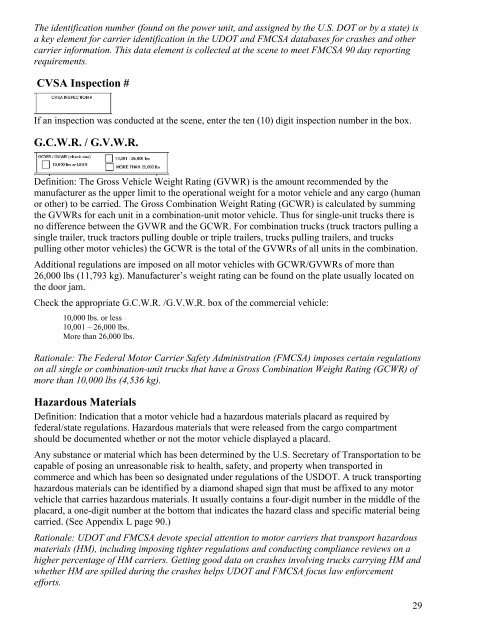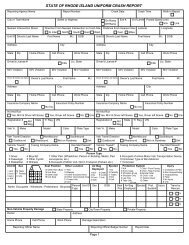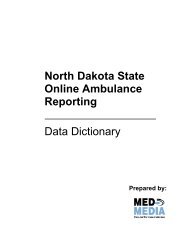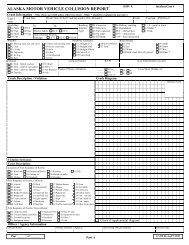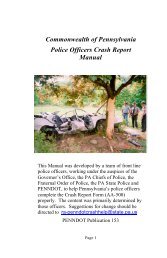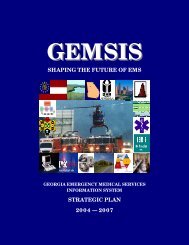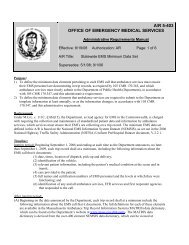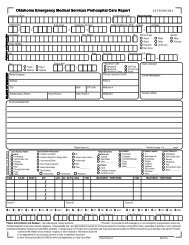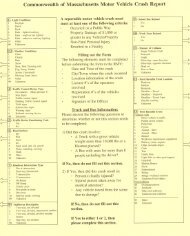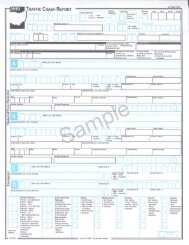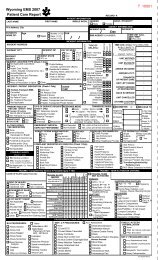DI-9 Manual PDF - Utah Department of Public Safety
DI-9 Manual PDF - Utah Department of Public Safety
DI-9 Manual PDF - Utah Department of Public Safety
You also want an ePaper? Increase the reach of your titles
YUMPU automatically turns print PDFs into web optimized ePapers that Google loves.
The identification number (found on the power unit, and assigned by the U.S. DOT or by a state) isa key element for carrier identification in the UDOT and FMCSA databases for crashes and othercarrier information. This data element is collected at the scene to meet FMCSA 90 day reportingrequirements.CVSA Inspection #If an inspection was conducted at the scene, enter the ten (10) digit inspection number in the box.G.C.W.R. / G.V.W.R.Definition: The Gross Vehicle Weight Rating (GVWR) is the amount recommended by themanufacturer as the upper limit to the operational weight for a motor vehicle and any cargo (humanor other) to be carried. The Gross Combination Weight Rating (GCWR) is calculated by summingthe GVWRs for each unit in a combination-unit motor vehicle. Thus for single-unit trucks there isno difference between the GVWR and the GCWR. For combination trucks (truck tractors pulling asingle trailer, truck tractors pulling double or triple trailers, trucks pulling trailers, and truckspulling other motor vehicles) the GCWR is the total <strong>of</strong> the GVWRs <strong>of</strong> all units in the combination.Additional regulations are imposed on all motor vehicles with GCWR/GVWRs <strong>of</strong> more than26,000 lbs (11,793 kg). Manufacturer’s weight rating can be found on the plate usually located onthe door jam.Check the appropriate G.C.W.R. /G.V.W.R. box <strong>of</strong> the commercial vehicle:10,000 lbs. or less10,001 – 26,000 lbs.More than 26,000 lbs.Rationale: The Federal Motor Carrier <strong>Safety</strong> Administration (FMCSA) imposes certain regulationson all single or combination-unit trucks that have a Gross Combination Weight Rating (GCWR) <strong>of</strong>more than 10,000 lbs (4,536 kg).Hazardous MaterialsDefinition: Indication that a motor vehicle had a hazardous materials placard as required byfederal/state regulations. Hazardous materials that were released from the cargo compartmentshould be documented whether or not the motor vehicle displayed a placard.Any substance or material which has been determined by the U.S. Secretary <strong>of</strong> Transportation to becapable <strong>of</strong> posing an unreasonable risk to health, safety, and property when transported incommerce and which has been so designated under regulations <strong>of</strong> the USDOT. A truck transportinghazardous materials can be identified by a diamond shaped sign that must be affixed to any motorvehicle that carries hazardous materials. It usually contains a four-digit number in the middle <strong>of</strong> theplacard, a one-digit number at the bottom that indicates the hazard class and specific material beingcarried. (See Appendix L page 90.)Rationale: UDOT and FMCSA devote special attention to motor carriers that transport hazardousmaterials (HM), including imposing tighter regulations and conducting compliance reviews on ahigher percentage <strong>of</strong> HM carriers. Getting good data on crashes involving trucks carrying HM andwhether HM are spilled during the crashes helps UDOT and FMCSA focus law enforcementefforts.29


